Abstract
The impact of ports on urban areas’ decarbonization to reduce air and environmental pollution effects to achieve sustainable development is undeniable, especially in the marine transportation sector. In this case, applied studies that can contribute to existing knowledge on increasing ports’ energy self-sufficiency using renewable energy sources (RESs) are critical and necessary. In this study, firstly, (1) the RESs assessment prioritization methodology was designed for Lazio ports. Additionally, (2) long-term solar radiation and wind speed were analyzed using the Modern-Era Retrospective analysis for Research and Applications, Version 2 (MERRA-2) dataset of Lazio ports. Furthermore, (3) the time-series, normal-distribution and correlation methods were applied to the generated energy source, based on various parameters of the RESs used in the ports. Finally, (4) Italian port areas, towards renewable energy community (REC) scenarios, were analyzed and developed.
1. Introduction
Ports produce about 3% of greenhouse gases (GHGs) worldwide [1]. In this context, seaports have used renewable energy systems in the last few years to fully or partially meet energy demand and to reduce their carbon footprint (towards zero carbon) [2]. However, current activities in ports significantly increase carbon dioxide (CO2) emissions, and the need for fundamental revisions should be according to their agenda [3]. Ports have outstanding energy sources for energy production from RESs to be considered as engine sources for next-generation programs due to their location and the high energy supply and demand activities that are carried out in ports. In this regard, ports should be close to electricity-production facilities, urban areas, transportation of raw materials, roads and railways.
Ports can be classified into three categories based on characteristics, such as the type of ship, the size of the ship that arrive at ports and the annual number of passengers visiting ports of different capacities [4]. (i) Local ports are ports that are large enough to meet the needs of a small island, usually full of small fishing boats and recreational boats. The number of small ships in these ports indicates the low capacity and lack of complex logistics processes. (ii) National ports are used to provide the transportation services required by a country. In these ports, services are provided to all different types of ships. These ports have the required logistical infrastructure to meet the basic needs of the area used. (iii) International and regional ports can meet international and regional needs due to adequate space and infrastructure [4].
Various studies have been conducted to achieve sustainable development and influence port sustainability, focusing on new tools and new technology [5]. In this regard, the definitions of port sustainability usually show that port sustainability is achieved only when all environmental, economic and social dimensions increase in these areas [6,7]. The main goal of port sustainability can be considered to be a socially acceptable and safe port that maximizes economic profit, is energy efficient and is environmentally friendly [5,8]. Furthermore, ports can be considered as one of the important ways to strengthen global economic decarbonization [9]. In this regard, a port can provide clean and renewable energy, using local sources to support ships with clean electricity [10].
The role of port energy management in the sustainable development of renewable energies is undeniable and can be easily implemented [11]. Interactions with stakeholders and decision makers in the sustainable development of the environmental management system can be considered the most crucial aspect of port energy management [12]. Energy management in ports can be aligned with urban strategies, including measures to expand the use of renewable energy, encourage environmentally friendly activities and protect the environment [13]. In this regard, the development of monitoring systems in critical environmental-performance indicators makes it possible to evaluate energy-consumption studies and the environmental-risk-management footprint [14,15]. Increasing the need for decision-making studies and empirical research based on the real experiences of port decision makers in implementing sustainable tools can help evaluate and select existing tools, technology and challenges [16]. The use of RESs in ports requires more complete and accurate information from the scientific community to enable port decision makers to make decisions with a lesser error probability [17]. Some studies have been carried out to evaluate the renewable energy supply application for the decarbonization of Italian ports [18], which included specific regulatory targets to be achieved. For example, applying wind and solar energy in ports has been implemented worldwide, and the statistics address the potential use of wind power in European ports [19,20]. Another approach to the use of alternative power source for maritime ports is the use of tidal and wave energies to power port operations [11,21]. Of course, reducing GHG and pollutant emissions is directly linked with energy-efficiency interventions, equipment electrification and the use of RESs and alternative fuels [22].
The first step in using RESs in the case of installation areas is to measure these energies over a long period. When choosing the most suitable RESs, the potential relationship of the RESs with the geographical location should be considered. According to studies conducted of ports, including the Rotterdam port in the Netherlands and the Kitakyushu port in Japan based using wind energy, the Campbell port in Australia using wave energy, and ports in Tokyo, San Diego, Los Angeles and Valencia using solar [23], tidal [21], wave [24] and wind energy, respectively, ports able to provide significant amounts of energy due to RESs’ significant potential. In this regard, several studies have been conducted to evaluate RESs in ports, but the lack of studies on which form of RES is more beneficial for use in ports, given the ports’ geographical location, is felt.
Agostinelli et al. [25] investigated a digitization policy to optimize maintenance processes and energy efficiency in port infrastructures to move towards the zero-energy zone. They considered the Anzio port in the Lazio region as a pilot project, started and developed as a particular example in the Mediterranean Sea. Furthermore, their study aimed to develop energy-saving strategies and integrate production systems using RESs for sustainable development. All stages of these applied strategies and energy analyss were carried out, starting from the current situation and showing the infrastructure potential in energy self-sufficiency. Finally, the authors discussed the potential of digital twins (DTs) research in the target area using BIM (building information modeling) and a GIS (geographic information system) to maximize the beneficial effect of energy-efficiency measurements. Karolina Fossile et al. [26] used a multi-criteria decision model of RESs to select which renewable energy type is most suitable for Brazilian ports. Their multi-criteria decision model will help to implement a linear-planning model to identify suitable options for the use of RESs. The assessments showed that solar (PV) energy is the most sustainable RES for investment in Brazilian ports. They also argued that, given the increasing competitiveness of ports, it could be very effective to provide new methods that can assist ports in making critical decisions, especially in selecting RESs. Therefore, they suggested that developing and designing new models to measure RESs in port studies can help improve energy efficiency and management in the future. Akbari et al. [27] examined ports’ logistics capabilities, using the physical characteristics of ports and their connection and design to support the installation, operation and maintenance of offshore wind projects. The relative importance of these criteria using the analytical hierarchy process (AHP) determines the relative importance of the metrics. They then used the AHP in a case study as a decision-making tool to enable port decision makers to assess the port’s understudy suitability for the installation of an offshore wind farm in the United Kingdom.
The ‘energy community’ (EC) concept is also known as ‘renewable energy community’, ‘citizens energy community’, ‘community self-consumption’, or ‘simple community’, and it is based on the open and voluntary participation of citizens. The EC manages activities, such as the generation, distribution, supply, consumption, aggregation, energy storage, energy efficiency of or the charging services for electric vehicles [28]. Moreover, the primary purpose of ECs is to provide environmental and social benefits to the local area and financial profits. Energy communities play a significant role in facilitating citizens’ participation in the energy system, as people and enterprises join collective energy initiatives, aiming to supply the members’ energy needs through renewable energy sources. The energy market, as well as the related legal, administrative and social aspects, are some of the main factors facilitating the energy communities’ development [29].
This study aims to validate a decision method to identify RESs’ potential interventions in Lazio ports. In this case, a recent decision method was designed to enhance network intelligence better to manage RESs for the decision making and monitoring of the ports’ energy needs. In this case, solar and wind were measured using the Modern-Era Retrospective analysis for Research and Applications, Version 2 (MERRA-2) data of four Lazio province ports. The time-series, normal-distribution and correlation methods were applied to the generated energy-source parameters based on solar and wind speed used in the ports. Finally, Italian port areas towards REC scenarios were analyzed and developed. This paper is organized as follows: Section 2 described port studies; Section 3 summarizes an integrated methodology of RESs selecting; Section 4 shows the obtained results and discussions; and Section 5 presents the conclusions.
2. Port Areas Description
In this article, four ports of Lazio were studied (Figure 1): (a) Anzio is a city and commune on the Lazio coast region of Rome [25]; (b) Formia is situated on the Gaeta Gulf [30]; (c) Terracina is an Italian city and commune of the Latina province of Rome; (d) Ventotene is one of the Pontine islands in the Tyrrhenian Sea [31].
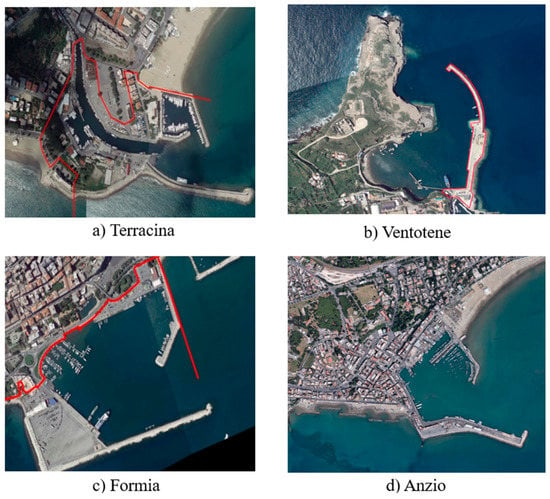
Figure 1.
Lazio port’s location and limitation areas of each port showed.
3. Materials and Methods
The methodological (Figure 2 and Figure 3) approach consists of the following four phases: Section 3.1. long-term wind-speed and solar-radiation analysis; Section 3.2. hourly wind-speed and solar-radiation data analysis; Section 3.3. wind-speed and solar-radiation statistical analysis; and Section 3.4. Italian port areas towards REC scenarios.
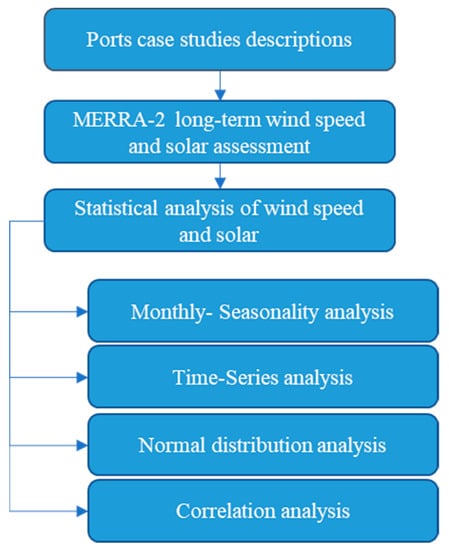
Figure 2.
The methodology description flowchart summarizing ports’ renewable energy source prioritization methodology.
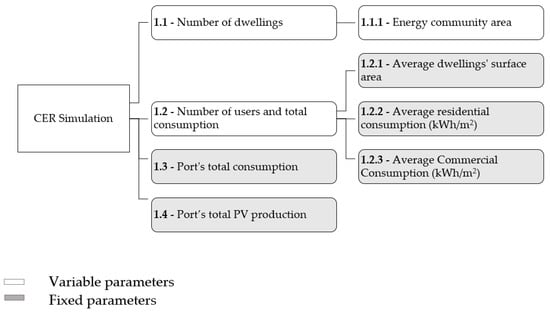
Figure 3.
Fixed and variable parameters for the EC’s scenario.
3.1. Long-Term Wind-Speed and Solar-Irradiation Assessment
Firstly, more than ten years of monthly data from 2011 to 2021 by the MERRA-2 re-analysis dataset were used to evaluate and identify the wind-speed and solar-radiation potential of classification ports.
3.2. Port’s Analysis Using Hourly Wind-Speed and Solar-Irradiation Data
Secondly, one year of hourly data from 2020 to 2021 by the MERRA-2 re-analysis dataset was used to assess the wind speed and solar potential time-series analysis of port areas to better understand the decision making. Furthermore, using wind data from step one, the power density of the wind was analyzed applying Equation (1).
where ρ is the standard air density at sea level, with a mean temperature of 15 °C and a pressure of 1 atmosphere (1.225 kg/m3), and v is the wind speed (m/s). Furthermore, the hourly data from the years included in the re-analysis dataset, relative to port area out-puts, were used.
3.3. Statistical Analysis of Wind Speed and Solar Radiation
Pearson’s linear correlation coefficient (CC) [32] test was used to analyze the level of correlation between the wind-speed and solar-radiation data of the four ports. The CC of the population between two sets generated randomly, X and Y, are defined as follows:
where and are the expected values of X and Y, and both and are the standard deviations (SD). In the next step of the wind-speed and solar-radiation data statistical analysis, an autocorrelation test was used [33]. The auto-CC lag k () for a sequential time series , was defined as follows:
where denotes the sample variance of the sequential time-series data, T is the effective sample size of and is the average of time series . Generally, , depending on the time-series data length.
3.4. Italian Port Areas towards REC Scenarios
The phases introduced two different simulation scenarios of ECs performed in the Anzio and Terracina ports. The simulations were carried out through the RECON (Renewable Energy Community ecONomic simulator), a web application released by ENEA and aimed at supporting preliminary energy, as well as economic and financial assessments, to develop RECs. For the Anzio port, a simulation was carried out in the EC-only residential buildings that do not have autonomous renewable energy production. On the other hand, two different simulations were carried out for the Terracina port: (a) the first simulation included residential buildings without the energy production from RESs; and (b) the second simulation included “prosumer” buildings, which integrate PV panels. The primary building use is residential and commercial.
At first, the simulations’ variable parameters were: (i) the number and type of dwellings in the EC; and (ii) the number of users and related total consumption in the energy community. The simulations’ fixed parameters were: (i) the port’s total consumption, deduced from electric bills; and (ii) the port’s total PV production, deduced from the number of roofs and structures for photovoltaic panels. For further simulations of Terracina’s port, the PV production was a variable parameter related to the number of buildings within the EC.
4. Results and Discussion
The re-analysis dataset was used for wind- and solar-potential assessment analysis, a time series of RESs’ potential classification analysis, and decision-making strategy.
4.1. Long-Term Wind-Speed Assessment
Figure 4 shows the wind speed analyzed using the re-analysis dataset for the four case studies of Lazio. Figure 5 and Figure 6 show a monthly and seasonally wind-speed hourly time series from 2020 to 2021 for the four Lazio ports. The wind power of the port case studies are shown in Table 1.
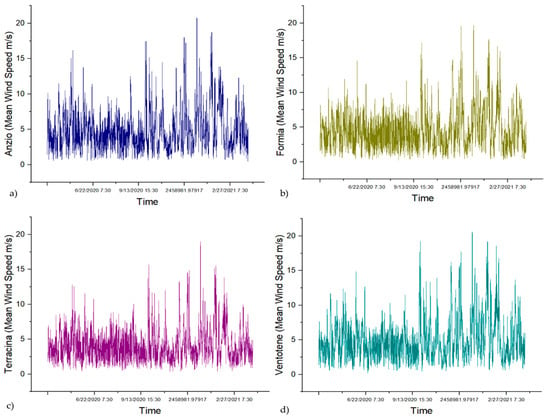
Figure 4.
Mean wind speed (m/s) of hourly time series for Lazio ports from 2011 to 2021: (a) Anzio; (b) Formia; (c) Terracina; (d) Ventotene.
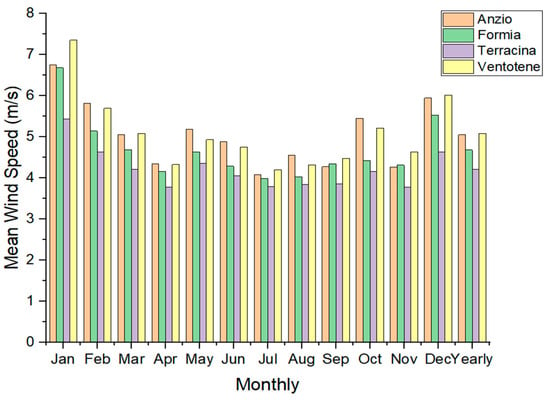
Figure 5.
Monthly mean wind speed (m/s) for Lazio ports from 2011 to 2021.
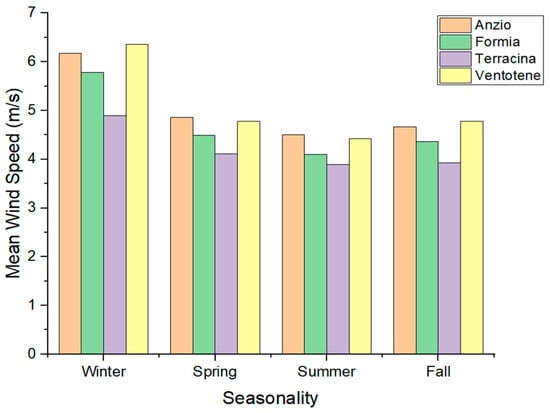
Figure 6.
Seasonal mean wind speed (m/s) of the Lazio ports from 2011 to 2021.

Table 1.
Wind and solar powers of ports case studies.
4.2. Long-Term Solar-Radiation Assessment
Figure 7 shows the solar radiation analyzed using the MERRA-2 re-analysis dataset for the four case studies of Lazio. Figure 8 and Figure 9 shows the four Lazio ports’ monthly and seasonal solar radiation using an hourly time series from 2020 to 2021. The solar power of the port case studies are shown in Table 1.
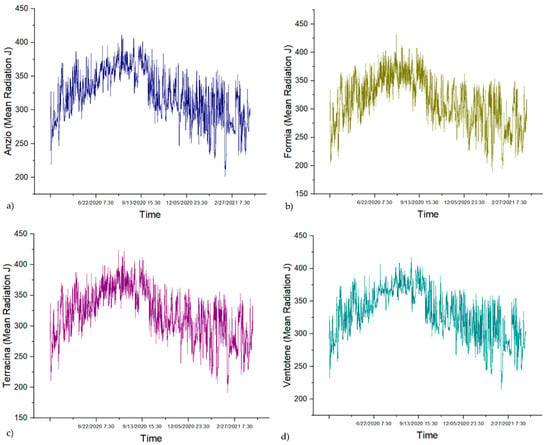
Figure 7.
Mean solar radiation (J) hourly time series for Lazio ports from 2011 to 2021: (a) Anzio; (b) Formia; (c) Terracina; (d) Ventotene.
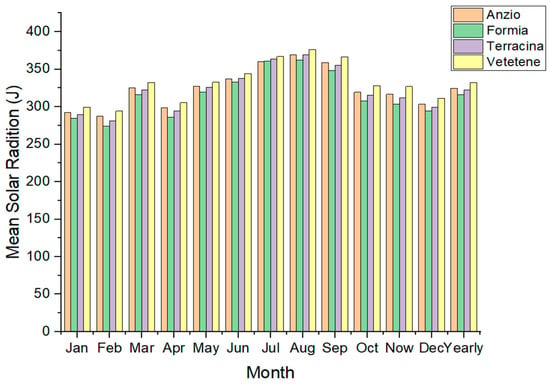
Figure 8.
Monthly mean solar radiation (J) hourly time series for Lazio ports from 2011 to 2021.
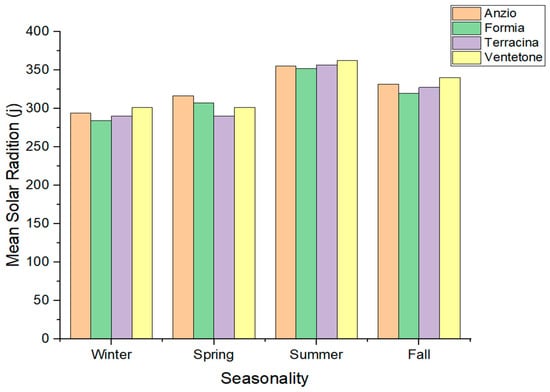
Figure 9.
Seasonal mean solar radiation (J) for Lazio ports from 2011 to 2021.
4.3. Statistical Analysis of Wind Speed
The frequency, mean and SD of the wind-speed values calculated for the available time-series data of the four ports and are exhibited in Figure 10 ((a) Ventotene, (b) Anzio, (c) Terracina, and (d) Formia). As a result, it can be seen that the minimum and maximum average wind speed recorded is related to the Terracina and Ventotene ports at 4.175 and 5.065 (m/s), respectively.
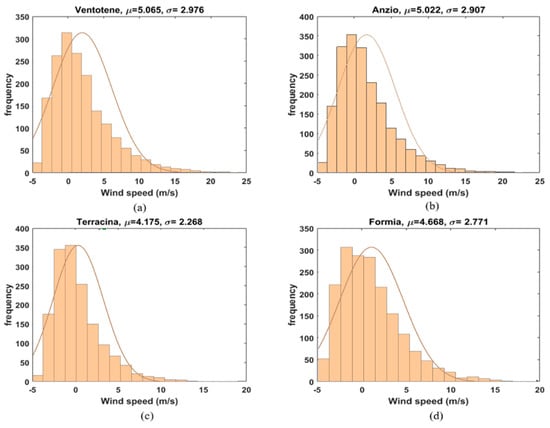
Figure 10.
The wind-speed data normal-distribution fit histogram for Lazio ports: (a) Ventotene; (b) Anzio; (c) Terracina; (d) Formia.
Figure 11 shows the scatter, histogram and CC of each pair location. First and foremost, the observation positively affects all ports regarding the wind-speed data. Secondly, the highest positive CC can be noticed between the Ventotene port and the Formia port.
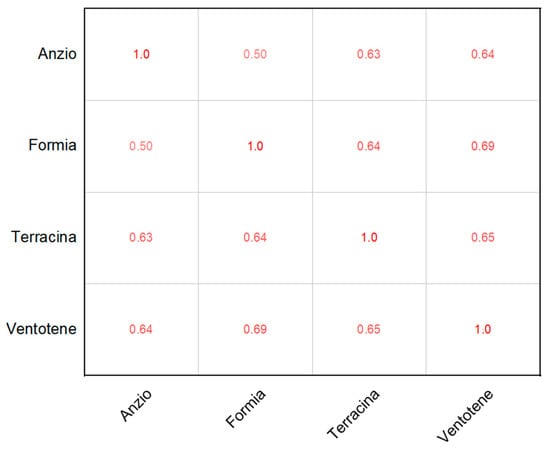
Figure 11.
Pearson’s linear CC is depicted using variable pairs for the wind-speed data ports.
4.4. Statistical Analysis of Solar Radiation
Figure 12 shows the solar radiation’s highest correlation between the Formia and Terracina ports at 0.85. Furthermore, it can be seen that the correlation among all ports is positive and high. This is based on expectations because the distance between these ports is not far.
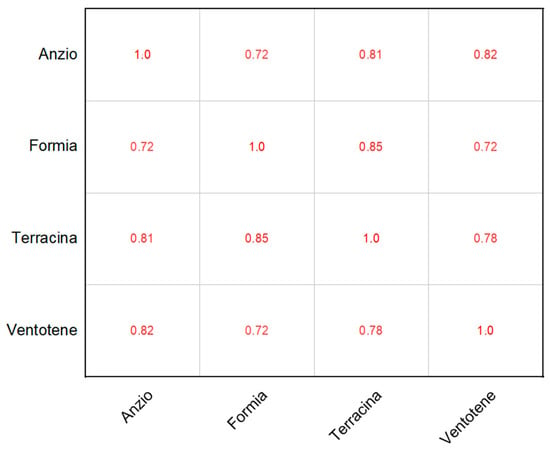
Figure 12.
Pearson’s linear CC is depicted using variable pairs for the solar-radiation data ports.
The Ventotene/Anzio ports and the Ventotene/Terracina ports can be considered as having good potential for installing solar and wind turbines, respectively. Therefore, this RES potential level in the Ventotene port can significantly contribute to energy self-sufficiency in this port/island and lead to its energy self-sufficiency. Studies show that more than 80% of world trade is conducted through ports every year [34]. The impact of this global economic growth is that ports have been accompanied by an increase in maritime transport, which has created competition between ports [35]. In addition, this increase in marine transportation has changed the ports’ sovereignty. On the other hand, ports face significant challenges related to climate change and the transition from fossil fuel to renewable energies. Therefore, due to the increase in sustainable transportation and logistics, local and national development regions have increased their attention to the port-integration perspective system. To achieve this goal, the introduction of new knowledge about complex port-related interactions is novel, as it will affect the ports’ performance due to the decision makers’ increasing power [36,37].
4.5. Simulation and Analysis of RECs’ Scenarios
The first simulation was performed in the Anzio port, consisting of a pier and a breakwater, with a total of 400 berths for boat-docking and yachts. All the berths are equipped with water and electrical connections for a service fee. The dock services are managed by Capo d’Anzio SpA, a global service company established in 2010 to promote and manage the town’s port. In addition, port services, such as bars, restaurants and shops, are completely integrated into the city’s commercial area. The first step was the EC simulation, including the port and the surrounding urban areas, through the port’s energy and energy-efficiency interventions identification. As a result, the most suitable area for deploying RES systems was identified by considering technical feasibility, visual impact and the optimization of PV production (shading, optimal orientation of modules, etc.).
The first step was the efficiency interventions, which mainly focused on lighting systems, consisting of about 67% (260,975 kWh) of the total electrical load. The efficiency interventions based on installing LED-lighting systems would reduce energy consumption by about 65% (90,155 kWh). The global lighting intervention reduced the whole port consumption by about 43%. In order to achieve a zero-energy district (ZED) or better, namely a positive-energy district (PED), the second action was the design of RES systems able to supply at least the whole port area’s energy needs. According to systems’ requirements and the local distribution of local radiation, the 16 photovoltaic-covered structures (5° inclination) were positioned in the parking area near Piazzale Marinai d’Italia, covering approximately 800 m2 and producing 200 kW for about 260,000 kWh per year (Figure 13). As such, the entire port area’s energy consumption (222,000 kWh per year) was covered through RES integration, resulting in the positive-energy district configuration, where the exceeded production (40,000 kWh per year) could be provided to the EC.
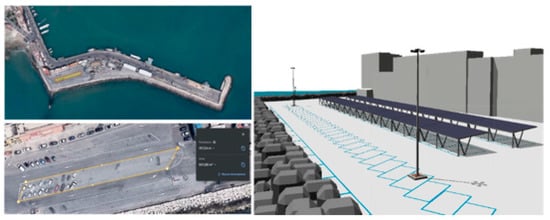
Figure 13.
RES systems’ positioning.
The second scenario was analyzed within the Terracina port. It is a canal port, protected to the south by the Gregorian pier and to the north by a reef pier composed of two docks where 200 boats can be hosted. Thus, the efficiency interventions were only based on replacing lighting systems with new LED systems, reducing the overall port energy consumption by about 40%. Then, the charging station installation, photovoltaic panels and wind turbines were also included in the simulation. For the installation of PV structures, the central parking row was considered to cover about 385 m2. Photovoltaic panels, consisting of 400 W monocrystalline modules, were installed for a total amount of 55 kW, globally producing 71,500 kWh with a surplus of energy of about 20,000 kWh per year to create an energy community.
In the first scenario, buildings without PV-production systems near the port were identified in the north Terracina area. A total of 10 full-residential buildings and two of commercial uses on the ground floor were selected. For each simulation, a different number of included buildings was identified to analyze the EC-related energy self-sufficiency to the number of connected assets. The simulation was performed with the following assumptions:
- The average area of the dwellings is 80 sqm.
- All the buildings can be attributed to an energy class ranging from F to G.
- The average consumption of the dwelling is assumed to be 3288 kWh.
The same assumptions were considered for the second scenario, which involved deploying the PV system on the buildings’ roofs within the EC, according to the area’s geometric configuration. Figure 14 shows which buildings were used in the simulations. For each building, the maximum number of PV panels that could be installed was calculated through BIM-based simulations. Table 2 shows the PV energy power installed on different buildings and their distribution within the simulations.
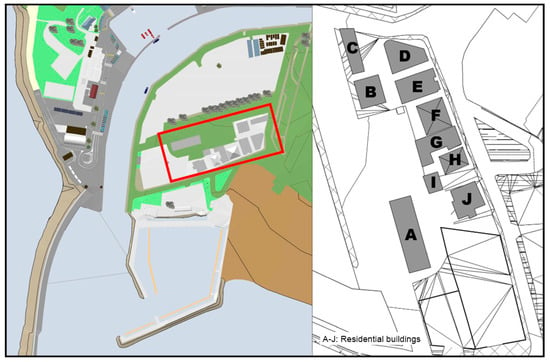
Figure 14.
Residential buildings included in simulations.

Table 2.
Buildings’ PV production within the simulations.
The simulation’s purpose was to define a primary tool to support the configuration of self-sustainable-energy communities. After predicting the fixed number of commercial activities involved in the energy community, the critical variable was assigned to the number of dwellings and, consequently, to the total energy consumption of the residential cluster, as shown in Figure 14. The main outputs obtained from the simulations can be summarized as follows:
- Annual electricity consumption and production;
- 1.1.
- Total electricity consumption,
- 1.2.
- Photovoltaic production,
- 1.3.
- Physical self-consumption (consumer with the same point of delivery (POD) as the renewable source PV system),
- 1.4.
- Energy supplied into the grid (difference between photovoltaic production and physical self-consumption),
- 1.5.
- Daytime electricity consumption,
- 1.6.
- Shared energy (energy consumed by RECs’ consumers),
- 1.7.
- Surplus energy (energy not consumed by RECs’ consumers),
- 1.8.
- Energy consumed (sum of physical self-consumption and shared energy),
- Energy and environmental indexes
- 2.1.
- Physical self-consumption index (ratio of physical self-consumption to photovoltaic production),
- 2.2.
- Virtual self-consumption index (ratio of shared energy to photovoltaic production),
- 2.3.
- Total self-consumption index (sum of physical self-consumption index and virtual self-consumption index),
- 2.4.
- Energy self-sustainability index (ratio of energy used to total electricity consumption),
- 2.5.
- Annual CO2 avoided,
Table 3 and Table 4 summarize the most relevant input and output data within the two different simulations.

Table 3.
First simulation: input and output data.

Table 4.
Second simulation: input and output data.
Figure 15 compares the indexes to evaluate the Anzio port’s energy community. In particular, the physical self-consumption index was constant when the PV production and the port’s energy demand were fixed. The virtual self-consumption index and the total self-consumption index increased according to the number of dwellings involved in the EC. The energy shared with REC members increased as the exceeded energy supplying the national power grid decreased, considering the same PV production.
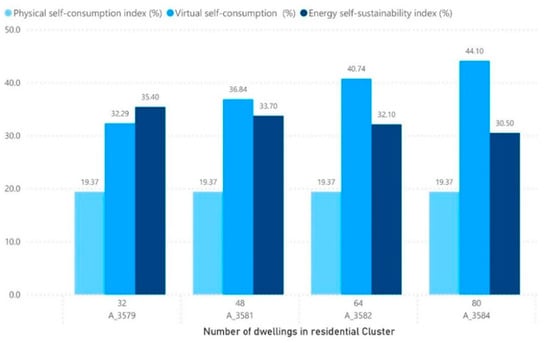
Figure 15.
Anzio’s REC classification indexes.
Therefore, this trend results in autonomous energy production and self-consumption, avoiding using expensive storage systems. The energy self-sustainability index had a negative trend as the number of dwellings involved in the energy community increased. However, this negative trend could be reduced by lowering total electricity consumption through efficiency interventions on buildings’ envelopes and heating systems.
In Figure 15, the simulation results consider the port as a single prosumer of the EC (with the same configuration as the Anzio port shown in Figure 15). In Figure 16, the simulation results are shown, considering that all the buildings connected to the EC are also energy prosumers. In the first scenario, the energy production was related to the port, and it emerged that PV production was constant in all the simulations.
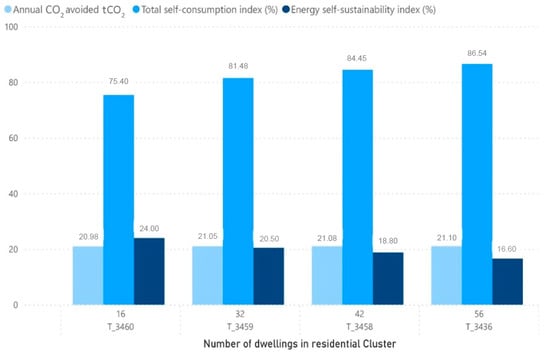
Figure 16.
Terracina’s REC classification indices, PV production constant.
The simulations differed only in the number of dwellings within the residential cluster; consequently, the total REC electricity consumption was variable. The graph shows that, without considering an increase in PV production, the amount of CO2 avoided was constant. However, a slight upward trend emerged, related to an increase in the total self-consumption index (TSCI). This is because the TSCI represents the energy from PV directly consumed by the REC. Therefore, the cleaner energy consumed by the REC, the less energy from fossil sources will be used to satisfy the REC’s electricity demand. Therefore, increasing the TSCI corresponds to a decrease in the REC’s energy self-sufficiency index.
To further clarify:
The TSCI is the sum of the physical self-consumption index (PSCI) and the virtual self-consumption index (VSCI). The PSCI is the PV production’s ratio to the total internal PV energy used directly within the port. The VSCI is the PV production’s ratio to the total internal PV energy used by the neighboring buildings’ consumers belonging to the REC. As such, the TSCI corresponds to the internal PV energy percentage used by the community. The energy self-sufficiency index (ESSI) is the total electricity-consumption ratio of the community to the total internal PV energy used by the REC.
The simulation does not include storage systems for the energy produced by the REC, so it emerged that the energy from the RES is self-consumed while it is produced. The exceeded amount of energy is provided to the grid. As the REC increases user numbers, consumer demand for electricity increases, causing the PSCI index to rise. On the other hand, the VSCI index is constant, according to energy consumption. Consequently, the total self-consumption Index increases. The increase in consumer demand for electricity results in an increase in the REC total consumption, which is not matched by a consistent increase in the total energy used by the community, resulting in a decrease in the ESSI.
According to the simulations performed in Figure 16 and Figure 17, to increase the EC sustainability factors, the CO2 reduction and the gap between the TSCI and ESSI were considered. Therefore, the RES-production systems’ installation in the new buildings included in the energy community could be a solution, as assumed in the Terracina port’s second scenario. Figure 17 shows that, in the second scenario, a more significant improvement in the first two indexes can be identified in the simulations. As a result, all the trends in the energy self-sustainability indexes were completely reversed, significantly increasing according to the number of buildings involved in the REC.
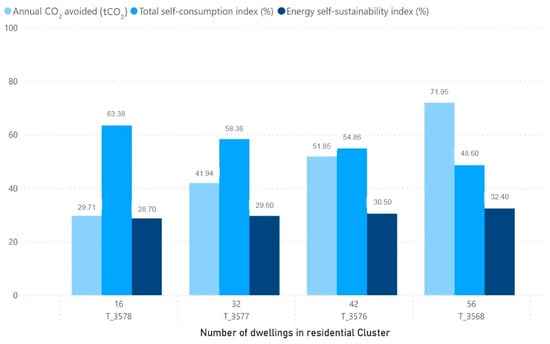
Figure 17.
Terracina’s REC classification indices, PV production increasing.
5. Conclusions
Ports are infrastructures which allow the integration of RES-production systems. Discontinuity characterizes the infrastructure morphology in both daily and seasonal uses. Large spaces and the proximity to the sea allow the implementation of RES-production systems to use different sources, such as solar or/and wind. The RESs’ analysis can effectively reduce project failure by providing decision-making support to stakeholders. In this case, solar and wind were measured using the Modern-Era Retrospective analysis for Research and Applications, Version 2 (MERRA-2) data of ports. Furthermore, time-series methods were considered to design better management of RESs for the energy-needs and decision-making monitoring of the ports. Three different time resolutions were applied to compare the complex relationship between the four ports. The analysis revealed how the energy potential of ports can create a surplus of valuable energy for RESs’ configuration. The simulations performed are related to renewable energy production from PV systems. The energy-production systems’ implementation from wind sources would increase the amount of energy produced, achieving better results in both self-consumption and energy self-sufficiency, as the energy produced from wind sources is not limited to a condition of cyclical production.
Moreover, the port infrastructure can be configured as the central hub of an REC, and the efficient management of consumption and production are needed. The simulations demonstrate that the transition of the REC’s users, from consumers to prosumers, is crucial for sustainable development and energy efficiency in urban areas. As a final remark, this study shows that the methodology proposed can help improve decision-making analysis for port areas, including urban areas.
Author Contributions
Conceptualization, S.A.; M.M.N. and M.N.; methodology, S.A.; M.M.N. and M.N.; software, S.A.; M.M.N.; validation, M.M.N. and M.N.; formal analysis, S.A.; M.M.N. and M.N.; investigation, S.A.; M.M.N. and M.N.; resources, S.A.; M.M.N. and M.N.; data curation, S.A.; M.M.N. and M.N.; writing—original draft preparation, S.A.; M.M.N. and M.N; writing—review and editing, M.M.N. and M.N.; visualization, S.A.; M.M.N.; M.N., G.P. and D.A.G.; supervision, G.P. and D.A.G. All authors have read and agreed to the published version of the manuscript.
Funding
This research has been carried out within the project “An integrated multidisciplinary and multiscale digital approach fostering the decarbonisation of port areas” protocol RG12117A8A106E46, funded by Sapienza University of Rome, Italy.
Institutional Review Board Statement
Not applicable.
Informed Consent Statement
Not applicable.
Data Availability Statement
Not applicable.
Conflicts of Interest
The authors declare no conflict of interest.
References
- Misra, A.; Venkataramani, G.; Gowrishankar, S.; Ayyasam, E.; Ramalingam, V. Renewable Energy Based Smart Microgrids—A Pathway To Green Port Development. Strat. Plan. Energy Environ. 2017, 37, 17–32. [Google Scholar] [CrossRef]
- Ferretti, M.; Parola, F.; Risitano, M.; Tutore, I. Complementary Assets And Green Practices In Shipping Management: A Multiple Case Study Analysis. Int. J. Transp. Econ. 2016, 43, 379–396. [Google Scholar]
- Mat, N.; Cerceau, J.; Shi, L.; Park, H.-S.; Junqua, G.; Lopez-Ferber, M. Socio-ecological transitions toward low-carbon port cities: Trends, changes and adaptation processes in Asia and Europe. J. Clean. Prod. 2016, 114, 362–375. [Google Scholar] [CrossRef]
- Sifakis, N.; Tsoutsos, T. Planning zero-emissions ports through the nearly zero energy port concept. J. Clean. Prod. 2020, 286, 125448. [Google Scholar] [CrossRef]
- Iris, Ç.; Lam, J.S.L. A review of energy efficiency in ports: Operational strategies, technologies and energy management systems. Renew. Sustain. Energy Rev. 2019, 112, 170–182. [Google Scholar] [CrossRef]
- Kuznetsov, A.; Dinwoodie, J.; Gibbs, D.; Sansom, M.; Knowles, H. Towards a sustainability management system for smaller ports. Mar. Policy 2015, 54, 59–68. [Google Scholar] [CrossRef]
- Puig, M.; Wooldridge, C.; Michail, A.; Darbra, R.M. Current status and trends of the environmental performance in European ports. Environ. Sci. Policy 2015, 48, 57–66. [Google Scholar] [CrossRef]
- Bach, C.K.; Groll, E.A.; Braun, J.E.; Horton, W.T. Dual port vapor injected compression: In-system testing versus test stand testing, and mapping of results. Renew. Energy 2016, 87, 819–833. [Google Scholar] [CrossRef]
- Cerceau, J.; Mat, N.; Junqua, G.; Lin, L.; Laforest, V.; Gonzalez, C. Implementing industrial ecology in port cities: International overview of case studies and cross-case analysis. J. Clean. Prod. 2014, 74, 1–16. [Google Scholar] [CrossRef]
- Schipper, C.A.; Vreugdenhil, H.; de Jong, M.P.C. A sustainability assessment of ports and port-city plans: Comparing ambitions with achievements. Transp. Res. Part D Transp. Environ. 2017, 57, 84–111. [Google Scholar] [CrossRef]
- Acciaro, M.; Ghiara, H.; Cusano, M.I. Energy management in seaports: A new role for port authorities. Energy Policy 2014, 71, 4–12. [Google Scholar] [CrossRef]
- Boile, M.; Theofanis, S.; Sdoukopoulos, E.; Plytas, N. Developing a Port Energy Management Plan: Issues, Challenges, and Prospects. Transp. Res. Rec. J. Transp. Res. Board 2016, 2549, 19–28. [Google Scholar] [CrossRef]
- Acciaro, M.; Vanelslander, T.; Sys, C.; Ferrari, C.; Roumboutsos, A.; Giuliano, G.; Lee Lam, J.S.; Kapros, S. Environmental sustainability in seaports: A framework for successful innovation. Marit. Policy Manag. 2014, 41, 480–500. [Google Scholar] [CrossRef]
- Gibbs, D.; Rigot-Muller, P.; Mangan, J.; Lalwani, C. The role of sea ports in end-to-end maritime transport chain emissions. Energy Policy 2014, 64, 337–348. [Google Scholar] [CrossRef]
- Hall, P.V.; O’Brien, T.; Woudsma, C. Environmental innovation and the role of stakeholder collaboration in West Coast port gateways. Res. Transp. Econ. 2013, 42, 87–96. [Google Scholar] [CrossRef]
- Di Vaio, A.; Varriale, L.; Alvino, F. Key performance indicators for developing environmentally sustainable and energy efficient ports: Evidence from Italy. Energy Policy 2018, 122, 229–240. [Google Scholar] [CrossRef]
- Ng, A.K.; Zhang, H.; Afenyo, M.; Becker, A.; Cahoon, S.; Chen, S.-L.; Esteban, M.; Ferrari, C.; Lau, Y.-Y.; Lee, P.T.-W.; et al. Port Decision Maker Perceptions on the Effectiveness of Climate Adaptation Actions. Coast. Manag. 2018, 46, 148–175. [Google Scholar] [CrossRef]
- Kotrikla, A.M.; Lilas, T.; Nikitakos, N. Abatement of air pollution at an aegean island port utilizing shore side electricity and renewable energy. Mar. Policy 2017, 75, 238–248. [Google Scholar] [CrossRef]
- Lam, J.S.L.; Notteboom, T. The Greening of Ports: A Comparison of Port Management Tools Used by Leading Ports in Asia and Europe. Transp. Rev. 2014, 34, 169–189. [Google Scholar] [CrossRef]
- Maleki, A. Optimal operation of a grid-connected fuel cell based combined heat and power systems using particle swarm optimisation for residential sector. Int. J. Ambient Energy 2019, 42, 550–557. [Google Scholar] [CrossRef]
- Ramos, V.; Carballo, R.; Álvarez, M.; Sánchez, M.; Iglesias, G. A port towards energy self-sufficiency using tidal stream power. Energy 2014, 71, 432–444. [Google Scholar] [CrossRef]
- Thangavel, V.; Momula, S.Y.; Gosala, D.B.; Asvathanarayanan, R. Experimental studies on simultaneous injection of ethanol–gasoline and n-butanol–gasoline in the intake port of a four stroke SI engine. Renew. Energy 2016, 91, 347–360. [Google Scholar] [CrossRef]
- Hassan, H.; Abo-Elfadl, S. Experimental study on the performance of double pass and two inlet ports solar air heater (SAH) at different configurations of the absorber plate. Renew. Energy 2018, 116, 728–740. [Google Scholar] [CrossRef]
- López, M.; Iglesias, G. Long wave effects on a vessel at berth. Appl. Ocean Res. 2014, 47, 63–72. [Google Scholar] [CrossRef]
- Agostinelli, S.; Cumo, F.; Nezhad, M.M.; Orsini, G.; Piras, G. Renewable Energy System Controlled by Open-Source Tools and Digital Twin Model: Zero Energy Port Area in Italy. Energies 2022, 15, 1817. [Google Scholar] [CrossRef]
- Fossile, D.K.; Frej, E.A.; da Costa, S.E.G.; de Lima, E.P.; de Almeida, A.T. Selecting the most viable renewable energy source for Brazilian ports using the FITradeoff method. J. Clean. Prod. 2020, 260, 121107. [Google Scholar] [CrossRef]
- Akbari, N.; Irawan, C.A.; Jones, D.F.; Menachof, D. A multi-criteria port suitability assessment for developments in the offshore wind industry. Renew. Energy 2017, 102, 118–133. [Google Scholar] [CrossRef]
- de Almeida, L.; Cappelli, V.; Klausmann, N.; van Soest, H. Peer-to-Peer Trading and Energy Community in the Electricity Market: Analysing the Literature on Law and Regulation and Looking ahead to Future Challenges. International Energy Agency. 2021. Available online: https://library.wur.nl/WebQuery/wurpubs/fulltext/558791 (accessed on 1 September 2022).
- Biresselioglu, M.E.; Limoncuoglu, S.A.; Demir, M.H.; Reichl, J.; Burgstaller, K.; Sciullo, A.; Ferrero, E. Legal Provisions and Market Conditions for Energy Communities in Austria, Germany, Greece, Italy, Spain, and Turkey: A Comparative Assessment. Sustainability 2021, 13, 11212. [Google Scholar] [CrossRef]
- Cumo, F.; Curreli, F.R.; Pennacchia, E.; Piras, G.; Roversi, R. Enhancing the urban quality of life: A case study of a coastal city in the metropolitan area of Rome. WIT Trans. Built Environ. 2017, 170, 127–137. [Google Scholar]
- Cumo, F. Digital twin for critical infrastructures: The Ventotene Island port case study, Italy. Built Environ. 2021, 205, 217–222. [Google Scholar] [CrossRef]
- Benesty, J.; Chen, J.; Huang, Y.; Cohen, I. Pearson Correlation Coefficient. In Springer Topics in Signal Processing; Springer: Berlin/Heidelberg, Germany, 2009; pp. 1–4. [Google Scholar]
- Monti, A.C. A proposal for a residual autocorrelation test in linear models. Biometrika 1994, 81, 776–780. [Google Scholar] [CrossRef]
- UNCTAD, United Nations Conference on Trade and Development. Reveiw of Maritime Transport. 2018. Available online: https://unctad.org/system/files/official-document/rmt2018_en.pdf (accessed on 1 September 2022).
- Jia, H.; Lampe, O.D.; Solteszova, V.; Strandenes, S.P. Norwegian port connectivity and its policy implications. Marit. Policy Manag. 2017, 44, 956–966. [Google Scholar] [CrossRef]
- Fuenfschilling, L.; Truffer, B. The interplay of institutions, actors and technologies in socio-technical systems—An analysis of transformations in the Australian urban water sector. Technol. Forecast. Soc. Chang. 2016, 103, 298–312. [Google Scholar] [CrossRef]
- Vejvar, M.; Lai, K.-H.; Lo, C.K.Y.; Fürst, E.W. Strategic responses to institutional forces pressuring sustainability practice adoption: Case-based evidence from inland port operations. Transp. Res. Part D Transp. Environ. 2018, 61, 274–288. [Google Scholar] [CrossRef]
Publisher’s Note: MDPI stays neutral with regard to jurisdictional claims in published maps and institutional affiliations. |
© 2022 by the authors. Licensee MDPI, Basel, Switzerland. This article is an open access article distributed under the terms and conditions of the Creative Commons Attribution (CC BY) license (https://creativecommons.org/licenses/by/4.0/).